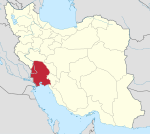| Tizno House | |
|---|---|
| Native names | |
| Location |  |
| Built for | Qajar dynasty |
| Rebuilt | 2002 (۱۳۸۱ shamsi date ) |
| Owner | Cultural Heritage, Handicrafts and Tourism Organization of Iran |
Tizno House is one of the oldest houses in the city of Dezful. The house is numbered 2573 in the National Iranian Art Series, and is one of the largest and most beautiful houses in the Quay neighborhood, which, in terms of architectural style, has all the features of the Dezful House. This structure has expanded on the eastern side of the main square of Qaleh Dezful's neighborhood and is compatible with the ecosystem and the city's lifestyle. The structure of the house dates to the Safavid era and has undergone many changes during the Qajar era. This house has eight entrances, a central porch, rooms on the porches, a slope of the living room, a chamber or a swaddling room, and a beautiful bricks of freezing and bleeding. [1] [2] [3] [4] [5] [6] [7] [8] [9] [10] [11] [12] [13] [14] [15] [16]
